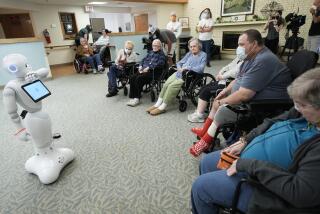Innovative Plans Seek to Help Elderly Pay for Extended Care
- Share via
The federal government, the insurance industry, consumer groups and the elderly themselves are grappling with ways to pay the soaring bills for long-term care for the elderly. Here are some of the innovative methods under consideration:
Insurance. Most insurance companies, afraid of large losses, have avoided insuring the elderly against the cost of long-term custodial care. But things may be starting to change. Long-term care insurance is now available from United Equitable Life Insurance, National States Insurance, Firemen’s Fund American Life Insurance, Aetna Life & Casualty, AI Life, CNA Insurance and Metropolitan Life. Availability varies among the states.
Benefits remain restricted and premiums are high, especially for the age groups most likely to need nursing home care. When Prudential Insurance and the American Assn. of Retired Persons test-marketed a policy last year, they offered benefits of $40 a day for nursing home costs and $25 for a nursing visit at home. The premium was $34.95 a month for ages 65 to 69, $64.95 for ages 70 to 74 and $94.95 for ages 75 to 79. No one 80 or older could enroll.
Long-term care insurance would be more attractive if Congress made the premiums tax-deductible, some experts say.
Tax-free savings accounts. Workers should be encouraged to save for nursing home costs if they could put savings into tax-sheltered Individual Medical Accounts patterned after Individual Retirement Accounts, says Health and Human Services Secretary Otis R. Bowen. Bills to establish such savings plans have been introduced in Congress but have not advanced.
Expanded federal benefits. A proposal by Rep. Edward R. Roybal (D-Los Angeles), chairman of the House Select Committee on Aging, would limit out-of-pocket payments for nursing homes to $500 a year and home care payments to $1,000. The federal government would pay the rest with revenues from increased cigarette taxes and a surcharge on individual and corporate income taxes.
Senate Aging Committee Chairman John Heinz (R--Pa.) would provide a tax credit for money spent caring for elderly persons with chronic illnesses.
At present, nursing home and home care expenses are tax deductions only when they are medically related. Beyond that, the so-called child care tax credit, for those who hire someone to care for a dependent so that the taxpayer can take a job, applies for elderly dependents as well as children.
Private groups have recommended extending Medicare benefits to long-term care. But in an era of massive deficits, all these proposals face little likelihood of quick enactment.
Health Maintenance Organizations. Some analysts say HMOs, which charge a fixed amount for membership and try to avoid unnecessary hospital expenses, may prove an economical way to finance long-term care. In a Medicare-related experiment, four HMOs in Long Beach, Brooklyn, N.Y., Portland, Ore., and Minneapolis have begun offering benefits for home health aides and other needs of frail elderly. But many question whether HMOs alone can take on the gigantic task of providing long-term care.
Life-care communities. In these campus-like settings, more than 100,000 older Americans are living out their days secure in the promise they will get any nursing and personal care they need. But life care typically entails a down payment of tens of thousands of dollars and continued monthly fees of several hundred dollars. Health care inflation and the increasing longevity of residents have forced some life-care communities out of business.
Home equity. “Reverse equity mortgages” could enable homeowners to make use of the money by trading the home equity to an investor in return for a source of income and the right to live at home. The investor takes over the property upon the original owner’s death. At least several hundred such agreements are in effect, but legal roadblocks exist in some states.
More to Read
Sign up for Essential California
The most important California stories and recommendations in your inbox every morning.
You may occasionally receive promotional content from the Los Angeles Times.










